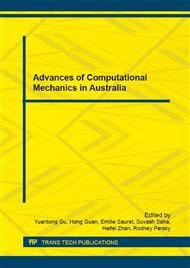[1]
Y. Kim, T.J. Oh, C.E. Misch, H.L. Wang, Occlusal considerations in implant therapy: clinical guidelines with biomechanical rationale, Clin. Oral. Implants. Research, 16 (2005) 26-35.
DOI: 10.1111/j.1600-0501.2004.01067.x
Google Scholar
[2]
S.J. Hoshaw, J.B. Brunski, G. Cochran, Mechanical loading of Brånemark implants affects interfacial bone modeling and remodeling, Int. J. Oral. Maxillofac. Implants, 9 (1994) 345-360.
Google Scholar
[3]
M. Nagasawa, R. Takano, T. Maeda, K. Uoshima, Observation of the bone surrounding an overloaded implant in a novel rat model, Int. J. Oral. Maxillofac. Implants, 28 (2013) 109-116.
DOI: 10.11607/jomi.2388
Google Scholar
[4]
D. Lin, Q. Li, W. Li, M.V. Swain, Dental implant induced bone remodeling and associated algorithms, J. Mech. Behav. Biomed. Mater, 2 (2009) 410-432.
Google Scholar
[5]
D. Lin, Q. Li, W. Li, N. Duckmanton, M.V. Swain, Mandibular bone remodeling induced by dental implant. J. Biomech, 43 (2010) 287-293.
DOI: 10.1016/j.jbiomech.2009.08.024
Google Scholar
[6]
N. Yoda, Y. Gunji, T. Ogawa, T. Kawata, K. Sasaki, In vivo load measurement for evaluating the splinting effects of implant-supported superstructures: a pilot study, Int. J. Prosthodont, 26 (2013) 143-146.
DOI: 10.11607/ijp.3223
Google Scholar
[7]
C. Rungsiyakull, Q. Li, G.Y. Sun, W. Li, M. Swain, Surface morphology optimization for osseointegration of coated implants, Biomaterials, 31 (2010): 7196-7204.
DOI: 10.1016/j.biomaterials.2010.05.077
Google Scholar
[8]
J. Chen, C. Rungsiyakull, W. Li, Y. Chen, M. Swain, Q. Li, Multiscale design of surface morphological gradient for osseointegration, J. Mech. Behav. Biomed. Mater, 20 (2013): 387–397.
DOI: 10.1016/j.jmbbm.2012.08.019
Google Scholar
[9]
J. Chen, R. Ahmad, H. Suenaga, W. Li, M.V. Swain, Q. Li. A comparative study on complete and implant retained denture treatments - A biomechanics perspective, J. Biomech, 48 (2014) 512-519.
DOI: 10.1016/j.jbiomech.2014.11.043
Google Scholar
[10]
J. Chen, W. Li, M.V. Swain, M. Ali Darendeliler, Q. Li, A periodontal ligament driven remodeling algorithm for orthodontic tooth movement, J Biomech, 47 (2014) 1689-1695.
DOI: 10.1016/j.jbiomech.2014.02.030
Google Scholar
[11]
F. Ramos Verri, J.F. Santiago Junior, D.A. de Faria Almeida, G.B. de Oliveira, V.E. de Souza Batista, H. Marques Honorio, P. Yoshito Noritomi, E. Piza Pellizzer, Biomechanical influence of crown-to-implant ratio on stress distribution over internal hexagon short implant: 3-D finite element analysis with statistical test, J Biomech, 48 (2015).
DOI: 10.1016/j.jbiomech.2014.10.021
Google Scholar
[12]
S. Ishigaki, T. Nakano, S. Yamada, T. Nakamura, F. Takashima, Biomechanical stress in bone surrounding an implant under simulated chewing, Clin. Oral. Implants. Research, 14 (2003) 97-102.
DOI: 10.1034/j.1600-0501.2003.140113.x
Google Scholar
[13]
V.A. Barao, J.A. Delben, J. Lima, T. Cabral, W.G. Assuncao, Comparison of different designs of implant-retained overdentures and fixed full-arch implant-supported prosthesis on stress distribution in edentulous mandible -a computed tomography-based three-dimensional finite element analysis, J. Biomech, 46 (2013).
DOI: 10.1016/j.jbiomech.2013.02.008
Google Scholar
[14]
C. Rungsiyakull, J. Chen, P. Rungsiyakull, W. LI, M. Swain, Q. LI. Bone's responses to different designs of implant-supported fixed partial dentures, Biomech. Model. Mechanobiol, 14 (2015) 403-411.
DOI: 10.1007/s10237-014-0612-6
Google Scholar
[15]
C. Field, Q. Li, W. Li, M.V. Swain, Influence of tooth removal on mandibular bone response to mastication, Arch. Oral. Biol, 53 (2008) 1129–1137.
DOI: 10.1016/j.archoralbio.2008.06.013
Google Scholar
[16]
C. Field, Q. Li, W. Li, M Thompson, M.V. Swain, Prediction of mandibular bone remodelling induced by fixed partial dentures, J. biomech, 43 (2010) 1771-1779.
DOI: 10.1016/j.jbiomech.2010.02.016
Google Scholar


